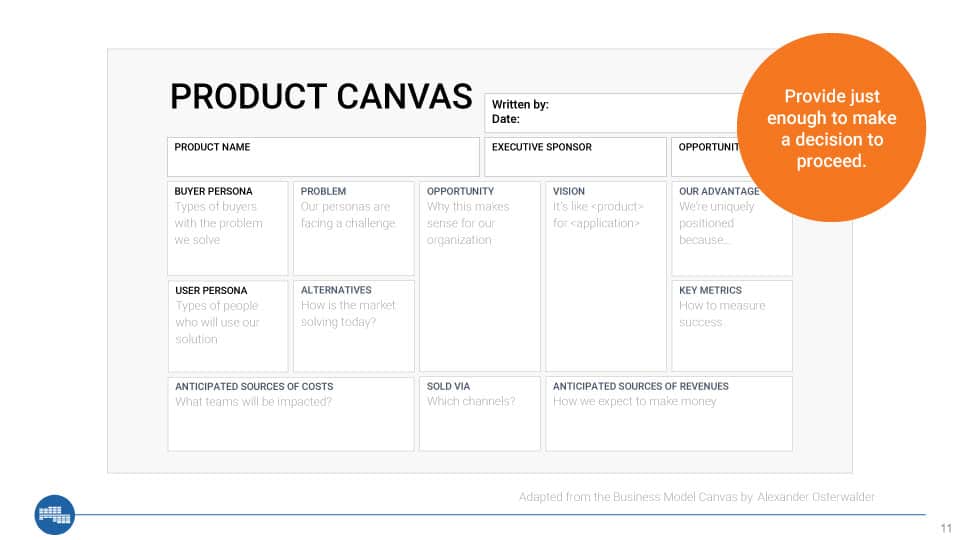The Ultimate Guide to Product Business Plans
Business plans are essential tools for evaluating the viability of a new product or product release. But today’s business plans are not what they once were. Instead of being detailed missives, today’s product business plan is more succinct and direct.
Still, the business planning process should consist of an objective analysis of potential market opportunity to provide a basis for investment. It continues to be the primary tool for product managers to use to communicate the business justification and projections for their products and services to leadership and investors, which is why it’s important to get your product business plan right.
Business plan definition and contents
A product business plan is a document that provides justification for a new product or product release, including the product’s potential and the quantifiable risks. The business plan is then used to communicate with leadership and investors so they may be able to decide which ventures to fund and which to delay or terminate.
Product business plans take many forms, but ultimately they all serve the same purpose. Some are succinct, single-page documents, while others are four- to five-page presentation templates that summarize their plans. Online tools are emerging in the market to guide and track business planning data. And, though it’s not a best practice, some companies still require large documents or presentation decks and follow an arduous business planning process to fund and track projects.
Regardless of your company’s culture or management style, product managers should strive to develop agile planning documentation that is manageable, predictable, complete and current.
While each company’s product business plans will look different, it’s important that all business plans within an organization follow the same format and have the same objectives so they can be compared apples to apples.
No matter what your business plan looks like, it should:
- Document the market problems you’re trying to solve and why your company is best positioned to solve them.
- Explain the business reason for developing the product.
- Regularly track and update projects for accuracy and completeness.

The business plan is then used to communicate with leadership and investors so they may be able to decide which ventures to fund and which to delay or terminate.
Why a business plan is important
While product business plans can serve many purposes, they are most commonly used to:
Determine if a product is worth pursuing. The business planning process and resulting plan will help you determine if a product you’re considering developing is actually worth pursuing. It will give you a good idea of whether you have the expertise, market, budget, resources and more to succeed.
Justify funding. One of the top reasons for creating a business plan is to communicate standardized, value-based information, regardless of the project type, to justify new or continued investment. This includes regular reporting on the progress being made against the original committed plan and any adjustments made to the plan due to changing product or market conditions.
Outline the development process. It’s easy to lose sight of your goals once you get deep into product development, particularly when people are requesting features be added at every turn. A product business plan serves as a blueprint for developing a new product or release that should be referenced frequently to ensure the project doesn’t get too off track. That’s not to say the plan won’t change—it will, and sometimes even drastically—but changes should be made purposefully and strategically. What you want to avoid is ending up on a different, unverified path simply because you neglected to refer to your business plan.
Product business plan limitations
While we strongly suggest going through the business planning process and consulting your product business plan early and often, the business plan is not written in stone. Nor does it provide any guarantees. No matter how much time and effort you put into compiling your plan, it has its limitations.
Let’s face it: A business plan is conjecture. You’re guessing at what’s going to happen because you’ve never done this before. You can’t guarantee any aspect of your business plan. What’s more, there’s no correlation between business plans and business viability. Your business plan is a hypothesis, a theory on what you believe will happen. While you can work with researchers and make some truly educated guesses, at the end of the day, they are still guesses. You have to test that theory in the running of your business or the development of your product, and if you don’t get started, you’ll never know what will happen. So, go ahead and put together your business plan. But don’t let perfecting your business plan keep you from doing, creating and developing.
Types of product business plans
As we mentioned, a product business plan can take many forms. Some CEOs are old-school and want to see every detail worked out in a 50-page tome. Thankfully, most leaders these days don’t have time to read all of that. We certainly know you don’t have time to write it.
Other companies prefer a truncated version of the traditional business plan distilled down into four or five pages. Download this business plan template if that’s your style.
Another option for outlining your plan is to use the “10-slide pitch.” As Gregg Scoresby, CEO of CampusLogic, explained in our webinar Why Your Business Plan Is a Waste of Time, you’ll create a slide deck that looks like this:
- Slide 1: Title
- Slide 2: Problem/opportunity (Describe the pain your product will alleviate or the pleasure it will provide.)
- Slide 3: Value proposition (Explain the value of the pain your product will alleviate or the value of the pleasure it will provide.)
- Slide 4: Underlying magic (Describe your product’s secret sauce. Better yet, include a demo.)
- Slide 5: Business model (Explain who has the money to purchase this product and how you’re going to get it.)
- Slide 6: Go-to-market plan (Discuss how you’ll reach your customer without breaking the bank.)
- Slide 7: Competitive analysis (Provide a complete view of the competitive landscape.)
- Slide 8: Management team (Introduce the key players on your team to illustrate capability.)
- Slide 9: Financial projections (Provide a three-year forecast that includes not only the dollars and cents but other key metrics like conversion rate and customers.)
- Slide 10: Use of funds (Explain where the project currently stands and how you intend to allocate your budget.)
View the webinar for a more in-depth look at the 10-slide pitch.
At Pragmatic Institute, we’re big proponents of short and sweet, which is why our favorite product business plan is actually the product canvas that our very own VP of Products, Steve Johnson, described in our Business Plans Are About Vision, Not Precision webinar. In the product canvas model, you’ll summarize all the research you’ve done and everything you’ve learned during the business planning process onto one page. That doesn’t mean you can skate on the legwork; you still need to do your due diligence. What it means is that you’re going to communicate your plan succinctly so that everyone can get on the same page—literally, just one page—without spending a ton of time.
Once you’ve done your research, you should be able to complete this product business plan in about an hour, and executives will be able to read and understand it in just a few minutes.
As you can see, your product canvas will address the following:
- Opportunity score: The numerical value of your could-we/should-we analysis
- Buyer persona: The types of buyers with the problem your product solves
- Problem: The challenge your personas are facing
- Opportunity: Why this makes sense for your organization
- Vision: It’s like “product” for “application”
- Our advantage: Why you’re uniquely positioned to solve this problem
- User persona: The types of people who will use your product
- Alternatives: How is the market solving this problem today?
- Key metrics: How you’ll measure success
- Anticipated sources of costs: What teams will be affected?
- Sold via: Which channels?
- Anticipated sources of revenue: How do you expect to make money?
Each box in the product canvas should contain no more than three sentences. To learn more about what to include in each box and how to calculate your product’s opportunity score, tune in to the product canvas webinar.
How to write a product business plan
No matter what format your product business plan takes, you’ll need to perform the following steps in the business planning process.
Step 1: Confirm your company’s business strategy
It doesn’t matter how great your idea for a new product is. If it doesn’t fit into your company’s overall strategy, it’ll be dead in the water. So make sure you’re intimately familiar with your company’s strategy. If there isn’t one or one isn’t clear, clarify prior to moving forward with any product business plan.
Product management is in a good position to persuade executives to develop a high-level strategy as part of the product planning process. Here are some key questions that product managers can ask executives to help with product planning:
- What are the top three most critical challenges our company will address this year?
- In which geographic regions will we focus on selling our products?
- Will there be any changes to the sales or channel strategy?
- What are the revenue and profitability expectations for each product line?
- Will there be any changes to the focus of marketing and advertising?
- Are new markets or product lines being considered for the future?
- What strategic partnerships are on the horizon?
- What resource changes are expected for the coming year?
Now, an astute executive may ask the product management team to answer or help answer many of these questions. And that makes some sense since product management sees market opportunities, has heard customer feedback first hand and has aggregated it from others, has tracked competitor’s moves and has an in-depth view of their products’ financial trends. But at the same time, you still want to leverage the knowledge and experience of the executive team and make sure they agree with the assumptions and logic being used.
Therefore, a practical approach to strategic planning could involve a meeting (or series of meetings) where product management presents their market and customer information to executives, who then have a chance to discuss what they have heard and how they think it should apply to the future of the company.
Step 2: Establish your product vision
Once you have a firm grasp on the company’s strategy, now it’s time to nail down your product vision. Your product vision is kind of like a mission statement for your product. With it, you’ll define an overarching goal for your product. What do you hope it will do for customers? What problem will it address? Who will your product benefit? You can think of the product vision as your why statement.
Down the road, your vision statement will evolve into a fully-fledged positioning statement, but for now, a brief description will suffice.
Step 3: Conduct research and answer key questions
You’ve already determined your market problems, conducted a win/loss analysis and mapped your competitive landscape in an effort to validate your idea. If you haven’t, do those steps now.
When you’re pretty sure there’s a need for your product and that the market is ready for it, next, you’ll need some inclination as to what it will cost and what its potential value is. Providing revenue and profitability estimates will be critical to making good product decisions and developing effective strategies. Leadership will likely consider:
- Size: How large is the opportunity relative to other business opportunities?
- Shape: How does it target our most profitable and satisfied segments?
- Direction: How will it affect the trajectory of the business?
Learn how to determine the answers to these questions by reading more about creating a comprehensive business plan.
Step 4: Score the opportunity
Your product idea seems solid. The market appears to be ripe. The competitive landscape looks good. Before plowing ahead, it’s time to have an honest conversation with yourself and your team for a gut check. Review all your research and answer the following questions:
- Are we passionate/excited about the idea?
- Do we have the right reputation for delivering this type of product?
- Does our product solve the problem in a new way?
- Do we have data/research to support the validity of our product?
- Do we have the expertise and knowledge to deliver the product?
Next, score your product by answering the following questions:
- Is it aligned with our market and product strategy?
- Will it affect our market competitiveness?
- Does the product fit in with our portfolio?
- Will it increase revenue or cost savings?
- Can we get results relatively quickly?
Ideally, you’ll answer “yes, definitely!” to all of the above, but most of the time, that won’t be the case. These questions—or questions your company generates—should be asked whenever a new product is being considered. That consistency will allow leadership to determine which products are most deserving of development.
For a how-to on using weighted scoring and calculating the opportunity score for your product, watch the Business Plans Are About Vision, Not Precision webinar.
Step 5: Present your findings
Remember, effective product plans address market and customer needs and support the company’s growth strategy. Creating effective product plans can only be accomplished with strong communications between the product management team and the executive team. So while you’ll definitely want to get some time on the execs’ calendars to present your hard work, that meeting shouldn’t be the first time they’re hearing any of this. When it comes time to present your completed plan, populate that product canvas, build out that 10-slide pitch or write up your brief product business plan narrative. Whatever you do, be quick about it.
Momentum is much more important than having the perfect product business plan. Keep in mind that opportunity is perishable, and there are other companies out there trying to solve the same problem you are. Don’t let them beat you to market because you’re rewriting your plan. Finding a way to architect speed into your process is more important than a lot of clarity around it.

It doesn’t matter how great your idea for a new product is. If it doesn’t fit into your company’s overall strategy, it’ll be dead in the water.
How often should you update your business plan?
Plans change constantly, and launching new products is an up-and-down journey. Your product business plan should not be a static document. However, it’s difficult to say exactly how often you should update it. The short answer is that you should update it as frequently as it needs to be updated.
Because Pragmatic highly recommends streamlining your product business plan, it shouldn’t take a great deal of time or effort to update. Still, don’t forgo making progress on your idea in favor of tweaking your plan.
Read about the benefits and challenges of agile business planning.
Learn more about the business planning process
Product business plans have evolved over the years but remain essential tools for evaluating the viability of a new product or product release. Learn more about how to build an effective business plan and more in Pragmatic Institute’s Focus class today.






